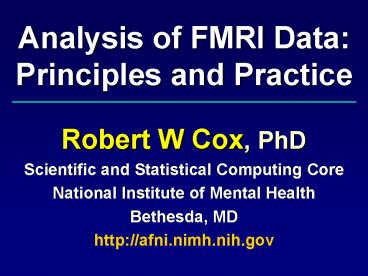Analysis of FMRI Data: Principles and Practice - PowerPoint PPT Presentation
Title:
Analysis of FMRI Data: Principles and Practice
Description:
Data analysis always takes place in the context of a ... and has the coolest logo. FSL: newish package from Oxford. Numerous other good packages out there ... – PowerPoint PPT presentation
Number of Views:60
Avg rating:3.0/5.0
Title: Analysis of FMRI Data: Principles and Practice
1
Analysis of FMRI DataPrinciples and Practice
- Robert W Cox, PhD
- Scientific and Statistical Computing Core
- National Institute of Mental Health
- Bethesda, MD
- http//afni.nimh.nih.gov
2
Principles Modeling
- Data analysis always takes place in the context
of a mathematical model - Model relates the properties of the system being
observed to the numbers that are actually
measured - Sometimes the model is implicit in the analysis
algorithm, rather than being explicitly stated - Model also needs to take into account properties
of the measurement system - Models relating FMRI signals to neural changes
are complex and tentative
3
Principles Data Quality
- FMRI data are crappy
- Signal changes with neuronal activation are small
(compared to noise), especially away from primary
sensory areas - Signal is several level of indirection away from
neuronal changes of interest - Numerous other signal fluctuations of non-neural
origin have similar or greater magnitude - Ghosting, warping, head movement, scanner
imperfections, heartbeat, breathing, long-term
drifts,
4
Conclusions from Principles
- It is better to explicitly state the mathematical
model rather than implicitly rely on an algorithm - It is a good idea to process FMRI data with more
than one model, to see if results change
significantly - It is important to examine the processed data
visually at each step in the analysis, to make
sure that nothing bad has happened
5
Practice Pattern Matching Models
- Looking for temporal (maybe spatial) patterns of
signal changes that you expect - Based on the external stimulus and/or measured
behavior - Searching low dimensional space of
pre-determined model to find best fit to data - Then test fitted model parameters for statistical
significance - Draw colors on top of significant voxels
6
Practice Pattern Hunting Models
- Looking for common temporal (maybe spatial)
patterns in the data - Fuzzy clustering tries to find voxel time series
that look alike and then creates clusters of
such similar voxels - Component analyses (PCA, ICA) try to find a small
set of time series that when combined properly,
explain most of the data in 10,000 voxel time
series - These analyses are exploratory rather than for
hypothesis testing - Difficult to assign statistical significance
7
Hemodynamic Model
- Measured MRI value in each voxel is sum of
- Slowly drifting baseline
- Hemodynamic response that is linearly
proportional to neural activity, delayed and
blurred in time - Non-neural physiological noise due to
respiration and blood flow pulsations through the
cardiac cycle - White noise from random (thermal) currents in the
body and the scanner - Imaging is assumed perfect
- Or at least is fixed up in preprocessing steps
8
Hemodynamic Equation
- Linear shift-invariant model for single voxel
time series - h(t) hemodynamic response at time t after
neural activity - s(?) neural activity at time ?
data v(t)
time
9
Ways to Use This Model
- Assume s(t) is known, and then
- Assume h(t) is known except for amplitude ?
correlation method - Assume shape of h(t) is also unknown ?
deconvolution method - Assume several different classes of s(t)s and
correspondingly several different h(t)s ?
generic linear model - Assume h(t) is known, and find s(t)
- Wiener deconvolution
- Try to find both h(t) and s(t)
- blind deconvolution
10
Further Considerations
- How many parameters to allow in unknown h(t)
depends on imaging TR, expected duration of
response, and stimulus timing event-related or
blocked - Appropriate baseline model depends on duration of
imaging run - May also include movement parameters
- Noise models can be simple or complicated
- Gaussian white noise
- Gaussian colored noise correlated in time
- Spatially correlated noise
11
Software Tools
- What package to use?
- Sociological answer the one your neighbors are
using (so you can ask them for help) - SPM most widely used at present
- AFNI flexible, customizable
- and has the coolest logo
- FSL newish package from Oxford
- Numerous other good packages out there
- Commercial products MedX, Brain Voyager































